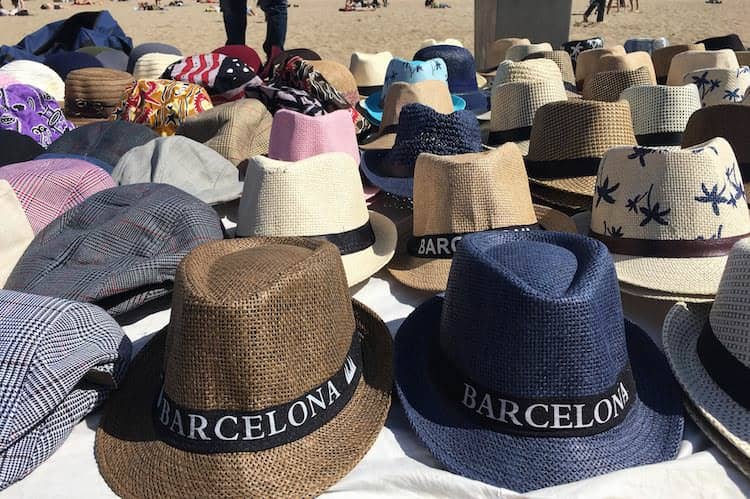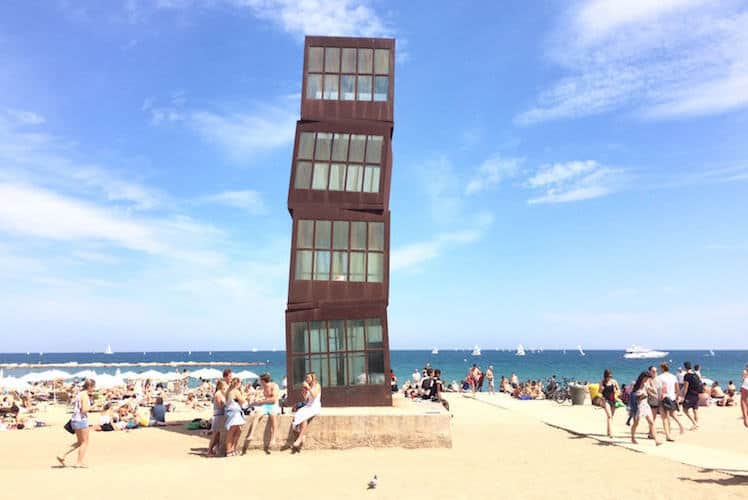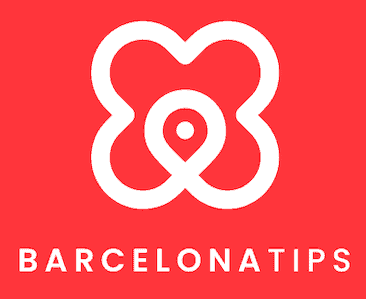Barcelona ranks with Miami, Sydney and Rio de Janeiro among the best beach cities in the world. A few steps from the city centre lie over five kilometres of golden sand. How nice is it that you can also take a dip in the Mediterranean sea during your city break? For the better beaches, head out of town.
| The beach of Barcelona | Tickets, opening hours & public transport |
|---|---|
| Price | Free |
| Address | Along the Barcelona coast |
| Public transport / metro | Metro: Barceloneta, Ciutadella – Vila Olimpica and Poblenou (L4) |
| Opening hours | n/a |
Contents
- The different beaches in Barcelona
- How to get to the beach?
- Eating and drinking at Barcelona’s beach
- 10 x things to see and do at the Barcelona beach
- Beach guard, flags and safety
- Beaches near Barcelona
- The origins of Barcelona’s beach
The different beaches in Barcelona
Platja de San Sebastià
This beach starts from the iconic Hotel W and runs to about the big surf shop Boardriders. Traditionally, Platja de San Sebastià was a nude beach, but since the arrival of the imposing Hotel W, it is no longer. That said, you will still find the occasional nude swimmer here.
Platja de La Barceloneta
By far the most popular beach in Barcelona. In summer, you lie here towel by towel. No wonder, as the beach is close to the city centre and there are plenty of food and drink outlets and supermarkets nearby. Between the two breakwaters there is a public gym. Ideal for growing your own muscles, or watching others do it!
Nova Icària
After Hotel Arts and Torre Mapfre, the two indispensable skyscrapers that stand to your left when you have the sea on your right, Nova Icària beach begins. This stretch of platja is easily accessible for those dependent on a wheelchair. There is also plenty of volleyball playing and ping-pong on this section.
Bogatell
Bogatell beach is a favourite with many locals. It is a lot less crowded than Platja de San Sebastià or Platja de la Barceloneta, yet the beach is easily accessible from the city. Moreover, you’ll find the excellent restaurant Escribà here.
Mar Bella
A little further north is Mar Bella beach, which also received a major metamorphosis for the 1992 Olympics. This beach is known as a place to be for gays and naturists (although only a small stretch of sand is reserved for the latter group). The Mar Bella skate park is a favourite destination of skating and BMX-end Barcelona.
How to get to the beach?
Barcelona’s beach stretches from the old fishing district of La Barceloneta northwards to neighbouring Badalona. All along the coast there are facilities such as showers, toilets and beach bars, called chiringuitos in Spain.
How you get to the beach depends on which platja you want to visit. If you go to Platja de San Sebastiá or La Barceloneta, it is best to take the metro to Barceloneta stop (L4, yellow line). From the metro station you can walk to the beach in ten minutes, via Passeig Joan de Borbó. From the centre, by the way, it’s a nice walk along the port to the beach and you might as well not take the metro.
For the beaches of Nova Icària or Bogatell, it’s better to get off at the Ciutadella – Vila Olimpica metro stop (L4, yellow line). Nova Icària is then about a 10-minute walk and Bogatell about 15 minutes.
Mar Bella is slightly less accessible by metro. I recommend you take the metro to Poblenou (L4, yellow line) and from there walk for another 15 minutes.
In addition, the beach is also easy to reach by bike. And if one beach isn’t quite to your liking after all, you can take your steel steed to somewhere else in no time!
The red and green routes of the Hop on Hop off bus also make stops at the beach. The green line only runs in high season.
Eating and drinking at Barcelona’s beach
Eating elaborate fish or having a drink somewhere with the sea breeze through your hair? These are my tips!
- Salamanca – A classic restaurant on Platja de la Barceloneta. You won’t be the only tourist there, but locals have also known how to find the joint for years. Celebrities like Shakira and her husband Piqué would love to come here. (Carrer de Almirall Cervera 32, (Barceloneta)
- Escribà – For the ultimate holiday feeling, order a big pan of paella and a good glass of wine here. Eat it with a sea view! (Avenida Litoral 62, (Ciutadella-Vila Olimpica))
- Maka Maka – The Dutch owners know what we crave on a beach day: good burgers (for both meat-eaters and vegetarians), fresh juices and cold cocktails. (Passeig Joan de Borbó 76, (Barceloneta)
- At Las Sardinitas they have good and very affordable paella (Avenida Litoral 26, (Ciutadella-Vila Olimpica))
- Can Fisher (Avenida Litoral 64, (Ciutadella-Vila Olimpica)) is where hip Barcelona gathers for a tasty seafood dinner by the sea.
Beach vendors in Barcelona
‘Beer, cerveza, agua, beer’. The owners of chiringuitos are not happy about it, but the many beach vendors are now indispensable on Barcelona’s beaches. Fancy a cold bottle of water, a coke or mojito? You can lazily order your drink from your towel. Other vendors will try to sell you a coloured beach towel and if you feel like it, you can get a massage. Beware: beach vendors are generally not licensed to do this work and the police keep a close eye on them. You can always try haggling. A realistic price for a can of beer or coke is 1.5 euros and you should not pay more than 15 euros for a beach towel like this.
Beautiful sand sculptures are also often created at La Barceloneta beach. Looking is allowed, but if you want to take a photo, you are supposed to give the creator a coin.

10 x things to see and do at the Barcelona beach
Not into hours of sunbathing? There is plenty to see and do on and around Barcelona’s beach:
1. Homage to Barceloneta
The block tower on Barceloneta beach is a popular meeting point for locals to meet their friends for a day at the beach. The tower, called L’Estel Ferit (‘the wounded star’), is a design by German Rebecca Horn and was erected here at the time of the Olympic Games. It is a tribute to the small shops that once stood on this part of the old fishing district of La Barceloneta, but had to clear out for the 1992 Olympics.
2. Peix d’Or
The goldfish near the two skyscrapers was designed by Frank Gehry in honour of, there they are again, the 1992 Olympics.
3. Hotel Arts and Torre Mapfre
Not to be missed in Barcelona’s skyline are these two tall towers, Barcelona’s first skyscrapers. Hotel Arts is a poopy chic hotel and Torre Mapfre is especially hardworking. Among other things, it houses the German consulate.
4. Volleyball
At Nova Icària and Bogatell beaches, volleyball is played all year round. You can bring your own net and ball and play a game in the designated areas, or ask to join a group.
5. Pingpong
Bring a little ball and play! At Bogatell beach there are several table tennis tables.
6. Fitness
Near the breakwaters on Barceloneta beach is a public gym (free of charge). If you really can’t resist during your holidays, you can work out here among the city’s biggest musclemen.
7. Sailing
From the sea, you have a great view of the coast and Barcelona’s various beaches. There are lots of opportunities to rent a boat or take a boat trip. For example, do a cruise during sunset with a drink on the side or join an ecological catamaran. You can float around on the water without any worries and while enjoying the sun and the view.
8. Surfing and supping (Stand up Paddle)
For experienced surfers, the Mediterranean is very boring, but for beginners it can be nice that the sea near Barcelona is calm. You can rent a board at, for example, Boardriders or Surf House in Barceloneta.
Another fun way to get out on the water without needing too many skills is stand-up paddle boarding. You can rent a board at Boardriders or Surf House. I don’t recommend taking lessons: after a few trial and error, you’ll master it on your own.
9. Nightlife
Just in front of the Olympic Harbour, you will find one of the city’s most popular nightlife areas. Popular nightclubs like Pacha, Opium and Catwalk attract many partygoers to the beach from around one o’clock at night. The entrance to the clubs are upstairs, on the boulevard. Those who have finished dancing can catch their breath on the beach.
10. Swimming
Not in the mood for sand between your buttocks, but want to cool off in the water? Then head to the pool in Barceloneta.
Tip: From the sea, you have a beautiful view of the coast and Barcelona’s various beaches. There are lots of possibilities to rent a boat or take a boat trip.
Beach guard, flags and safety
In high season, so between May and October, lifeguards are present all over Barcelona’s beach. They keep an eye on whether people are going too far into the sea and take action if necessary. Should you have a problem, you can ask the soccorista for help. When it gets dark, the lifeguards go home. This is then always briefly announced over the loudspeakers (in Catalan, Spanish and English).
A word about the flags. In principle, there is always a blue flag. This stands for the good quality of both the water and the beach itself, according to European standards. There is also always a green, yellow or red flag. Green means you can just go swimming. Yellow means you can go into the sea, but warns you to be careful (because of strong winds, for example). A red flag prohibits entering the water.
Beaches near Barcelona
Barcelona’s city beaches are ideal for a quick dip or to blow out after a day of wandering around the city. But for a relaxing day at the beach, I recommend leaving the city. The Cercanías regional train will have you under your umbrella within 20 minutes to 45 minutes.
The Cercanías/Rodalies train follows the coastline in northern (as far as the resort of Blanes) and southern (Tarragona) directions. You can get off wherever you like. Some popular beaches on the route are:
South of Barcelona:
- Castelldefels
Half an hour by train from Barcelona is the 6-kilometre-long beach of Castelldefels. It is not the most beautiful beach in Catalonia, but it is the best choice if you are looking for space and don’t want to travel long. Just make sure you take a train that stops at Castelldefels Platja station and not Castelldefels (the village) itself, because from there it’s quite a long walk to the coast. - Sitges
At first glance, Sitges’ beach seems as busy as Barceloneta’s, but make no mistake: Sitges has a dozen beaches. Behind the church are several small bays shielded by cliffs. Moreover, the resort itself is also very charming. Tip: at the sailing club on the pier at the foot of the church, you can get a good three-course meal at lunchtime and also sit in a fantastic spot. Sitges is also a must if you want a day out of town. - Vilanova i la Geltrú
Located between Tarragona and Barcelona, Vilanova i la Geltrú has six kilometres of beach along its coast. This is the first beach where more Catalans than tourists can be found.
North of Barcelona:
- Badalona, Montgat Nord, Ocata
Less than half an hour by train from Barcelona are the popular beaches Badalona, Montgat Nord and Ocata. This is where Barcelona locals themselves like to go to the beach. Wide beaches, fine sand and plenty of space. Moreover, there are plenty of facilities for children. From the train stations, you can walk straight onto the beach. Badalona and Montgat are still within zone 1 and Ocata is zone 2 by public transport. - Sant Pol de Mar
The Sitges of the Maresme coast. Sant Pol is a fine seaside resort with some lovely beaches and the train journey there is wonderfully relaxing. You travel a little further, but then you have something. The village itself is also worth a visit. - Tossa de Mar
Even further north are Tossa de Mar and Platja d’Aro, but these resorts can only be reached by car or bus.
The origins of Barcelona’s beach
Before the 1992 Olympic Games in Barcelona, the beach consisted mainly of rocks and Barceloneta was really not a beach where you just lay in the sand in the sun. Barcelona was known as the city that lived with its back to the sea. The current sandy beach was created by – how could it be otherwise – Belgians and Dutch!


